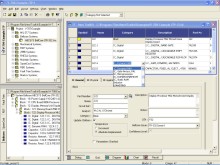Telcordia Standards Pdf
The requirements of telcordia GR-487-CORE are intended to provide a suitable environment for telecommunication companies’ electronic and passive equipment that is housed in above ground cabinets or enclosures, typically pad- or pole-mounted, in an Outside Plant (OSP) environment. Although originally developed for wireline environments, many of the wireless carriers have adopted GR-487 as a standard for their wireless environments as well.
GR-3108-CORE provides the test criteria for the equipment inside of a cabinet or enclosure, and works in harmony with GR-487. In general, if a cabinet or enclosure includes electronic or telecommunication equipment, this equipment is expected to comply with the criteria contained in GR-3108 (unless the equipment is covered by a more specific GR).
Standards based reliability prediction is a methodology for predicting the reliability of a product by using failure rate estimates published in globally recognized standards. With the release of Version 9, Lambda Predict now supports four reliability prediction standards: MIL-HDBK-217F, Bellcore/Telcordia (SR-332), NSWC-07 and FIDES. This article focuses on the Bellcore/Telcordia standard. Contents Telcordia GR-1275 - Documentation Information 1 Introduction 1.1 Reasons for GR-1275-CORE, Issue 7.
Captain tsubasa j full episode sub indo soccer. Of special note for Original Equipment Manufacturers (OEMs), equipment evaluated to GR-3108 expects a GR-487 enclosure to provide a Class 2 Protected Environment (thermally managed interior space within an outdoor enclosure) or Class 3 Severe Outside Environment (interior space within an outdoor enclosure that is not sealed or thermally managed). Cabinets and enclosures evaluated to GR-487 are anticipated to be deployed in a Class 4 (directly exposed to outside weather conditions) environment.
Applicable Equipment
GR-487 covers cabinets and enclosures deployed in the Outside Plant (OSP) environment. The range of enclosures include; wireline electronic equipment cabinets (DSLAM, DLC, cross-connect), wireless cabinets (backhaul switches, battery backup, base station transceiver, E-911 Location Measurement Unit, power amplifiers), field retrofit & adjunct cabinets, and power pedestals (housing for AC commercial power, battery backup).
Note that when Purcell Systems states that specific enclosures and cabinets comply with GR-487, we have tested and passed all the applicable requirements of this specification. Customers should ensure that enclosures under assessment have been tested to the applicable requirements, rather than designed (but not tested) to a subset of the requirements. Note that the laboratories that test to GR-487 do not provide a certification of approval. They provide a test report stating the test done and their results. Reputable enclosure manufacturers will provide copies of the test report. This test report is for a specific configuration in time, and the laboratory does not verify continuous compliance. Therefore, customers should ensure the test reports are relevant to the specific revision level they are assessing.
GR-487 Testing
Telcordia prohibits the disclosure of test sequences and parameters without prior written permission, so individual tests sequences cannot be publically disclosed. The range of requirements tested in GR-487 specification include:
- Finish
- Metallic Materials
- Polymeric Materials
- Lifting Details
- Security/Alarms
- Bonding & Grounding
- Vertical and Horizontal Door Restraints
- AC Power
- Exposure to High Temperature
- Surface Temperature
- Thermal Shock
- Water, Dust, an Insect Intrusion
- External Icing
- Acoustical Noise Emissions
- Firearms Resistance
- Fire Resistance
- Corrosion Resistance
- Shock, Vibration and Impact Resistance
- Seismic Resistance
- Marking, Packaging, and Shipping

Telcordia Standards Pdf Format
More Telcordia Information
Regulatory Information
| MTBF-Calculation acc. to Standards Mil-HDBK-217 →TelcordiaSR-332 IEC-TR-62380 SiemensSN 29500 FIDES2009 217Plus GJB/Z 299C | TelcordiaSR-332was the second electronicreliability prediction standard (after Mil-HDBK-217) and is still the second most popular ofall current electronic reliability prediction standards. With itslatest edition (issue 4) from 2016, Telcordia has undergone by far themost revisions and is therefore the oldest electronic reliability prediction standard; it has been consistently kept up to datefor many decades: Originally named Bellcoreissue 1,2,3,4,5 and 6, then hcanged into Telcordia issue 1,2 3 and 4. |
The Telcordia methodology isquitesimilar to the Mil-HDBK-217 methodology, however it tends to besimpler. Incontrast to Mil-HDBK-217,Telcordia uses only up to 2 component specific parametersper component type. Aditionally, these 2 parameters are easier todetermine (with the # of transistors or gates in ICs being the onlyexception). Similar methodology makes it quite easy to transformMil-HDBK-217 MTBF values into Telcordia MTBFvalues (and vice versa), provided that a reliability predictionsoftware is used.
 Telcordiaenvironment types areidentical with Mil-HDBK-217 environment types, but Mil-HDBK-217 offersmore environment types. The same is true for component coverage:Telcordia uses the same component categories like Mil-HDBK-217, butMil-HDBK-217 offers more component categories.
Telcordiaenvironment types areidentical with Mil-HDBK-217 environment types, but Mil-HDBK-217 offersmore environment types. The same is true for component coverage:Telcordia uses the same component categories like Mil-HDBK-217, butMil-HDBK-217 offers more component categories. Telcordia hassome uniquedifferentiators:
- Calculated MTBFs can be improved (or impaired) using laboratorytest data and field failure data
- same for Burn-In data
- Telcordia uses the gamma distribution with standard deviationsfor all component failure rates.
- ThereforeTelcordia MTBFs can be featured with confidence bounds, resulting insligthly lower MTBFs but with higher statistical certainty.
- This makes the Telcordia standard quite complex (however, thefrench standard IEC-TR-62380is even more complex, in a different way).
- Some Telcordia software don't offer this feature at all, andmany analysts aren't even aware of this feature.
Telcordia Standards Pdf Download
Taking into consideration every known aspect, Telcordia is probably thebest available standard of all electronicreliability prediction standards.Standards